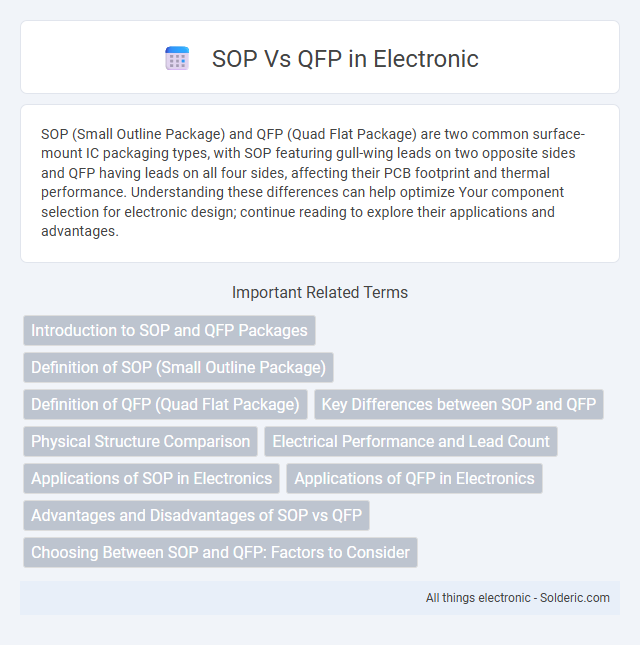SOP (Small Outline Package) and QFP (Quad Flat Package) are two common surface-mount IC packaging types, with SOP featuring gull-wing leads on two opposite sides and QFP having leads on all four sides, affecting their PCB footprint and thermal performance. Understanding these differences can help optimize Your component selection for electronic design; continue reading to explore their applications and advantages.
Comparison Table
| Aspect | SOP (Standard Operating Procedure) | QFP (Quality Function Deployment) |
|---|---|---|
| Definition | Documented process for consistent task execution | Method to translate customer requirements into product features |
| Primary Focus | Operational consistency and compliance | Customer-driven quality and design planning |
| Industry Use | Manufacturing, healthcare, corporate processes | Product development, engineering, quality management |
| Purpose | Ensure repeatable and standardized processes | Align product design with customer needs |
| Output | Step-by-step instructions and guidelines | Quality matrices and priority charts |
| Approach | Procedure-driven, rule-based | Analytical, customer requirement-focused |
| Benefits | Improved efficiency, reduced errors, compliance | Enhanced customer satisfaction, targeted improvements |
Introduction to SOP and QFP Packages
Small Outline Package (SOP) and Quad Flat Package (QFP) are two popular surface-mount integrated circuit packaging types used to enhance connectivity and heat dissipation. SOPs typically feature a rectangular shape with gull-wing leads extending from two sides, making them suitable for compact electronic devices. QFPs offer a square or rectangular body with leads on all four sides, providing higher pin counts and improved electrical performance in complex circuit applications.
Definition of SOP (Small Outline Package)
Small Outline Package (SOP) is a surface-mounted integrated circuit (IC) package type characterized by a rectangular shape with gull-wing leads extending from its longer sides for easier soldering on printed circuit boards (PCBs). SOP packages offer a compact footprint, making them ideal for medium pin counts and applications requiring efficient board space utilization. Their thermal and electrical performance is optimized for a wide range of electronic devices, including microcontrollers, sensors, and memory chips.
Definition of QFP (Quad Flat Package)
A Quad Flat Package (QFP) is a surface-mount integrated circuit package with leads extending from all four sides, designed for high-density electronic applications. It offers a low-profile solution with reliable soldering and excellent thermal performance, making it ideal for complex semiconductor devices. QFP packages enable efficient board space utilization compared to traditional through-hole packages like Small Outline Package (SOP).
Key Differences between SOP and QFP
SOP (Small Outline Package) and QFP (Quad Flat Package) differ primarily in lead configuration and application scope. SOP features leads on two sides, making it ideal for moderate pin counts and compact PCB designs, whereas QFP has leads on all four sides, supporting higher pin counts for complex circuits. Your choice depends on the device's pin requirements and available board space, influencing assembly and thermal performance.
Physical Structure Comparison
SOP (Small Outline Package) features a rectangular shape with gull-wing leads extending from the sides, designed for surface mounting on PCBs, while QFP (Quad Flat Package) has leads on all four sides forming a flat, square footprint ideal for high pin-count applications. SOP packages generally have a lower profile and fewer pins, making them suitable for simpler or smaller electronic devices, whereas QFP supports higher pin densities and better thermal performance due to its lead configuration. Understanding the physical structure of SOP vs QFP helps optimize your component selection based on space constraints and electrical requirements.
Electrical Performance and Lead Count
SOP (Small Outline Package) typically offers better electrical performance due to shorter lead lengths, which reduces parasitic inductance and capacitance, enhancing signal integrity in high-frequency applications. QFP (Quad Flat Package) supports a higher lead count, making it suitable for complex integrated circuits requiring numerous I/O connections, though longer leads can introduce increased signal delay and potential noise. The choice between SOP and QFP depends on the balance needed between electrical performance and lead count requirements for specific electronic designs.
Applications of SOP in Electronics
SOP (Small Outline Package) is extensively used in applications requiring compact, surface-mount components, such as in consumer electronics, automotive control systems, and telecommunications devices. Its design allows for efficient heat dissipation and high pin counts, making it ideal for integrated circuits like microcontrollers, memory chips, and operational amplifiers. SOP packages enhance assembly automation and reliability in densely populated printed circuit boards (PCBs), supporting miniaturization trends in modern electronic products.
Applications of QFP in Electronics
QFP (Quad Flat Package) is widely used in electronics for mounting integrated circuits with a high pin count, offering excellent leads for surface mounting on PCBs. Its applications span microcontrollers, memory chips, and complex digital devices in consumer electronics, automotive systems, and industrial controls. You benefit from QFP's reliable solder connections and compact design, which support advanced functionality in modern electronic assemblies.
Advantages and Disadvantages of SOP vs QFP
SOP (Small Outline Package) offers advantages such as a smaller footprint, easier automated soldering, and better electrical performance due to shorter leads compared to QFP (Quad Flat Package), which allows for higher pin counts suitable for complex circuits. However, QFP provides easier visual inspection and repairability because of its gull-wing leads extending outward, whereas SOP's tighter pin spacing increases the risk of solder bridging and complicates manual rework. Your choice between SOP and QFP depends on factors like board space constraints, pin count requirements, and manufacturing capabilities.
Choosing Between SOP and QFP: Factors to Consider
Choosing between SOP (Small Outline Package) and QFP (Quad Flat Package) depends on factors such as PCB space constraints, thermal dissipation needs, and pin count requirements. SOP offers a more compact footprint ideal for limited space and lower pin counts, while QFP provides higher pin density and improved heat management suitable for complex circuits. Assessing your device's electrical performance, assembly process, and cost implications will guide your optimal package selection.
SOP vs QFP Infographic

 solderic.com
solderic.com